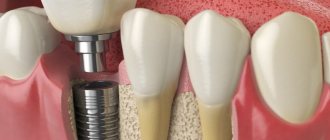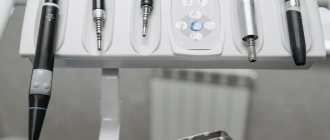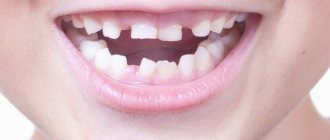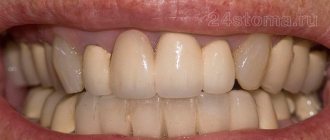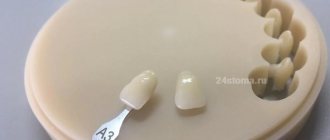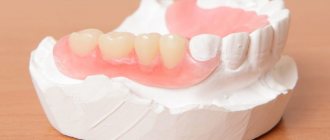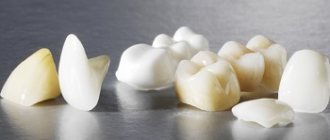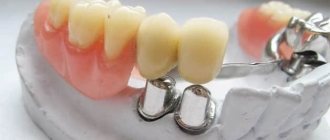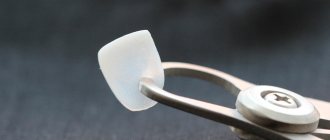Ceramic veneers are microprostheses for restoring the shape of a tooth and changing its color. They provide a long-lasting aesthetic effect that no other whitening method can provide. Due to their unlimited shelf life and high strength, they outperform composite materials used for dental restoration. At the same time, they are installed without traumatic treatment of the teeth, which cannot be avoided when using prosthetics with crowns.
What kind of design is this and its features
What kind of dentures are these and how are removable dentures different from all the others? Removable veneers are veneers that can be removed. It would seem nothing complicated. But in this simplicity lies either an advertising ploy - it misleads patients, or such veneers will soon have to be replaced with permanent ones - which in theory they should be.
It is worth saying that not a single self-respecting orthopedic dentist will offer a patient removable “veneers” as an option to improve the aesthetics of a smile. What's the point here? In general, veneers1 are non-removable microprostheses - overlay plates on the upper and lower front teeth, which make them more beautiful in shape and shade. But such onlays are made in a dental laboratory (this is important!) within a few days or weeks. During this time, the patient is given temporary plates - composite or plastic, which will soon be removed. They are needed to protect the ground teeth from damage and temporarily give them a natural look.
Those removable veneers that are offered to patients on websites on the Internet or in advertising videos and booklets are most often similar to conventional silicone dentures for the entire jaw. They also resemble the joke “jaws” that people wear to masquerades, and even chewing gum in the shape of jaws. They attach very poorly to the mouth and, according to patients, they are completely impossible to wear. You can see how “natural and natural” such products look before and after installation - see the photo.
Lumineers: indication and installation
This type of veneers, called lumineers, is installed when the patient has minor injuries:
- cracks and small chips without damaging bone tissue - lumineers will protect teeth from infection and further destruction;
- spots and darkening, especially with fluorosis;
- darkened or stained fillings on the front teeth;
- small gaps - lumineers are placed if the patient does not want to wear braces or use other systems to straighten the row;
- tendency to thinning enamel - lumineers ideally protect it and prevent destruction;
- severe erosions similar to caries or dark brown spots;
- underdevelopment of individual teeth;
- congenital yellowness of teeth that cannot be corrected by professional cleaning and whitening.
The cost of installing lumineers will be somewhat more expensive, since the manufacturing technology of these structures is more complex. The finished part is up to 0.5 mm thick (plus or minus 0.2-0.3 mm).
Lumineers are installed in almost the same way as veneers, only the stage of grinding the teeth is skipped. Sometimes a computer is used to design a smile: a 3D model of teeth is created instead of a dental cast.
Many lumineers are made in America, so the process takes from 1 month. But since there is no need to grind down the enamel, the waiting period does not in any way affect the patient’s well-being.
After production, lumineers are tried on - the technology is so precise that modifications are required only in 1-5% of cases. If it is needed, the lumineers are ground in a local laboratory. Before removing the 3D model, the patient’s oral cavity is also examined, and then treatment is prescribed if there is caries or other inflammation.
Micro-dentures are placed on teeth treated with a special solution using modern dental glue. The process of processing enamel is called etching - it is not traumatic. Installation of the thinnest plates is a safe and comfortable procedure for the patient; in rare cases, painkiller injections are required (in case of increased sensitivity).
Types of removable “veneers”
This group includes the following types of structures (although not all of them have the right to be called veneers):
- temporary onlays for teeth: patients wear them for about 2 weeks or more - up to 2 months. During this time, permanent onlays are made in the laboratory from ceramics, zirconium dioxide, and ceramic composite. Moreover, for both temporary and permanent overlays, the rule applies - each tooth has its own individual veneer, made from impressions,
- DenMat's Snap-On Smile Dentures: These are temporary dentures that look like veneers or crowns bonded together. They can be worn over the entire dentition or on a “problem” sector. Snap-On Smile not only improves the aesthetics of a smile, but can replace several missing teeth in a row. They are made individually from impressions sent to the manufacturer’s laboratory in the USA,
- removable “veneers” on teeth, “dental onlays” or “false teeth”, which can be purchased on the Internet, pharmacies or cosmetics stores: they look like a silicone prosthesis for the entire row, or single onlays that are glued at home yourself.
As for the last variety, there is no talk here of any individualized approach or taking casts. These “dentures” have a standard shape and are suitable for a person with perfectly straight teeth. But in any case, they will not stick well and will come off with a little pressure. So with such a “Hollywood smile” you can only smile (but even this is not a fact), but you won’t be able to chew food.
%akc72%
Bottom line
Perfect smile veneers are an imitation of the upper row of teeth along with the gums, thanks to which you can not be afraid to smile openly and joke. The perfect smile removable denture does not require a visit to the orthodontist or preliminary teeth grinding. To get a snow-white smile, you just need to put the denture on the upper jaw and hold it lightly until it takes the anatomical shape of your teeth. However, the perfect smile has a drawback: the lack of imitation of the lower jaw.
To correct small defects in the dentition, you can purchase lumineers: their installation does not require grinding of the enamel. If there are significant defects in the dentition, lumineers will not help, as they are made of completely transparent material. To correct large defects, ceramic onlays or plates made of composite material are required.
Sources used:
- The National Center for Biotechnology Information (USA)
- Proffitt U.R., Modern orthodontics (3rd edition), MEDpress-inform, 2015, 560 p.
- “Orthopedic treatment with fixed prostheses” (Rozenstiel S.F.)
What materials are they made from?
Overlay removable veneers are made of polymers, silicone, polypropylene, and plastic in light shades. These are inexpensive materials, they are easy to process and can be easily painted in enamel colors. But we must understand that even in professional dentistry such materials are used only on a temporary basis, because they have low performance characteristics. The materials are softer and more fragile than those used for real microprostheses. They also have irregularities and pores on the surface, into which dietary fiber and dyes become clogged.
Who is recommended for veneers and who is not?
In principle, any patient can get dental veneers if they have the funds and the desire. Most often, veneers are installed on teeth for the following reasons:
- not satisfied with the natural color of your teeth;
- there are stains or microcracks on the tooth surface that you want to disguise;
- if there are three (small distances a few millimeters wide);
- in cases where teeth are prone to increased wear at the edges;
- if there are minor orthodontic defects, for example, the tooth is slightly rotated, or mild crowding is diagnosed.
Note!
Even the most modern whitening technologies are not able to give tooth enamel such impeccable whiteness as microprostheses. That is why more and more patients are inclined to install veneers and make their dream of incredibly beautiful teeth come true! Like any restoration procedure, the installation of veneers has its contraindications. It will not be possible to install dental microprostheses if:
- the patient suffers from bruxism - otherwise, microprostheses will constantly break;
- when your teeth are loose and in poor condition, prosthetics will help here (possibly together with implantation);
- if the enamel thickness is insufficient or it is destroyed, then the microprosthesis will not hold;
- the teeth are naturally underdeveloped, too small - the structures simply will not be fixed on the surface;
- there are acute diseases of the ENT organs, problems with the heart and blood vessels, tumors, etc.
Relative contraindications are problems with bite and caries - these issues can be treated, and only after that you can work on the aesthetics of your smile.
Note! If a tooth has been restored by more than 60%, it has a large filling, and it is not advisable to install onlays on it. This can lead to subsequent destruction of the crown, and the patient will already spend a considerable amount on the installation of dental microprostheses. Perhaps in this case, prosthetics at the 32 Dent clinic will help.
Advantages and disadvantages
The advantages or benefits, if you can call them that, are that for not very much money you can get a new look for some kind of masquerade or photo shoot. Then there are the disadvantages, which are mentioned by reviews from dentists and people who decide to buy removable dental veneers. The disadvantages of removable dental veneers are as follows:
- poor fixation in the oral cavity,
- the risk of getting into an awkward situation in society,
- not very aesthetic appearance,
- rapid coloring of lining materials with food coloring, tobacco smoke, etc.,
- discomfort when wearing: such pads are made according to a template, so they will be uncomfortable after installation. After all, absolutely every person has their own individual parameters for the shape and inclination of their teeth, their sizes - it is impossible to measure everyone with one “ruler”,
- unpleasant “chemical” smell or taste from materials,
- risk of complications: damaged enamel, pulpitis, injuries to teeth and gums, chemical and thermal burns, allergic reactions to materials, risk of choking on a peeling pad or swallowing remaining adhesive.
“I placed an order in one group and was led by praise and a large audience. And I was very pleased with the price - it was only 500 rubles, to be honest. But on the day I received it, it turns out I was added to the blacklist. And I couldn’t leave my not at all positive review. These turned out to be not veneers at all, but some kind of toys, just to scare children with them. They do not stick to the teeth and fall out constantly. In general, horror!!!"
Marina_99, review from the woman.ru forum
Pain after teeth grinding and eating
After installation of veneers, you cannot eat for at least 2 hours. Over the next 2 days, the patient is asked to refrain from drinking coffee, berries, tea, red wine, beets, oranges and other citrus fruits, kiwi, and foods with dyes. For a month after installing the parts, you should not eat too hard foods or foods with small bones. It is better to give up seeds altogether forever.
Since 1 to 2 weeks pass between the preparation of teeth and the installation of veneers on a permanent basis, patients are interested in possible painful sensations. Indeed, teeth will ache even under temporary plates for a maximum of 4-5 days.
Avoid too cold or hot foods after grinding, as your teeth become very sensitive to it.
The same rule applies to rinsing your mouth after brushing your teeth. Use warm boiled water. In rare cases, pain medication may be required. If the pills do not help, you need to consult a doctor: severe pain that does not subside day and night may be a sign of an incorrect choice of temporary veneers.
How to use removable veneers
How to install and remove removable “veneers” will depend on their type. If the product is in the shape of a full jaw, then they are simply put on the teeth from above and removed from them by hand. Some sellers write that you first need to put the structure in hot water for a few minutes - almost boiling water - and then put it on. But in this case, there is a real risk of burning the gums and overheating the dentinal layer (it is located under the enamel), which can provoke pulpitis. Not to mention the discomfort of the installation process - some people report that it is painful or too hot for the teeth.
Removable “veneers”, which imitate real ones in their shape (but are sold in packs of 70 pieces, and are not made individually), are supposed to be fixed with a special adhesive using a brush and tweezers. And all this on your own at home. But if dentists use only professional formulations with proven components, then it is completely unknown what will end up in the package with “veneers”. It will be good if it is harmless glue (even if it comes off quickly). And if you come across a toxic substance that is difficult to remove, you will have to urgently seek medical help.
Care
Ceramic veneers require the same care as natural teeth. To preserve their aesthetics and extend their service life, it is recommended:
- reduce the consumption of foods with dyes (the linings will not change color, but the fixing cement may);
- wear a plastic mouthguard for bruxism - pathological grinding of teeth;
- do not subject teeth with veneers to increased stress (do not bite ice, do not open bottles, do not bite nails and hair ends, do not shell seeds);
- Do not miss dental checkups (once every six months).
What is better to choose?
If you understand the question of which removable “veneers” are better, then the only option would be Snap-On Smile dentures. They are made individually and from quality materials. But, since the plant is located in the USA, the patient will have to wait about 1-2 months, and the main waiting time will be spent on transportation. Again, you will have to first visit an orthopedist to take impressions and sanitize the oral cavity. As a result, the final cost of treatment can be close to installing real veneers.
Only until December 25 South Korean implant Osstem - from 18,500 rubles.
Hurry up to sign up for a free consultation and lock in promotional prices.
Call now or request a call
Opening hours: 24 hours a day - seven days a week
Hit list of questions and answers about veneers
Do veneers ruin your teeth?
Answer: teeth are spoiled by carious lesions, neglect of hygiene rules, lack of regular visits to the dentist, poor nutrition, and bad habits. Veneers, made of first-class material and installed by a professional dentist, on the contrary, protect the enamel from harmful external influences.
Is it painful to install?
Answer: no, it doesn't hurt. The procedure is performed under local anesthesia in a comfortable environment. It is important! There is no need to remove dental nerves during installation.
How long will it take to install?
Answer: on average, from 5 to 14 days or 2 to 3 visits to the dentist’s office.
Dental clinic "32 Dent" specializes in the installation of dental veneers on a turnkey basis. Both budget-class microprostheses and premium solutions are available, including patented American lumineers. Schedule an initial consultation with your doctor to choose the best path to restoring your smile with veneers. The smile will be beautiful and at the same time natural. Take action!
How much does a “Hollywood” smile cost?
How much do removable dental veneers cost? If you study the offers on various sites, the average price will be 1,200 rubles for a complete “transformation” of your smile. But, as practice and reviews of people who have decided to make such a change in appearance show, this is money down the drain. In reality, such products will not make your smile more beautiful, and they are impossible to wear.
If the patient is interested in the cost of temporary veneers, which need to be worn while the permanent ones are being made, then their cost, as a rule, is already included in the overall price tag. Those. there will be no additional costs. Classic non-removable ceramic onlays for teeth cost from 15 thousand rubles and more - it all depends on the cost of materials and methods of processing them. By the way, if necessary, the doctor will be able to remove them and install new ones if the need arises.
1Gurel G. Ceramic veneers, 2007.
Your questions and answers
QUESTION I bought removable veneers online, but I cannot attach them to my teeth. They fall off constantly. Tell me how to do this better? Alexandra
ANSWER Hello, Alexandra. Unfortunately, there is nothing we can do here. Because these are not veneers at all, but their imitation. Real veneers are installed in dentistry using a special adhesive composition - and remain on it for years. Also, real veneers are made based on impressions of the patient’s dentition, i.e. they are individual and precisely adjusted to the parameters of a particular person. Whereas “veneers from the Internet” are template overlays made according to standards known only to the manufacturers themselves. That's why they don't stick to the teeth. The use of any independently selected adhesives is unacceptable, as this can only harm yourself. Therefore, we do not recommend wearing these products. But you can use them for creativity, crafts - whatever your imagination allows.
Advantages and disadvantages
Advantages:
- high aesthetic effect (ceramics differs from composites in that it retains its original color and, with high-quality processing, is no different from a real tooth);
- biocompatibility (ceramic veneers are hypoallergenic);
- durability (compared to composite onlays, the short-term whitening effect and the five-year service life of a conventional filling);
- minimal or zero treatment of the tooth (the tooth is ground much more strongly for a crown).
Flaws:
- high cost (restoration with composite materials is cheaper);
- instability to heavy loads (can peel off and break);
- irreversibility of the preparation (the tooth ground under the veneer will no longer be able to function normally after the onlay is removed).
Why does conventional veneer placement disappoint patients?
Beautiful and durable veneers can only be made taking into account the characteristics of the patient’s bite, muscles and joints. For example, if a patient grinds his teeth or clenches them tightly in his sleep, there is a high probability of chips on the plates. Therefore, before making restorations, it is necessary to conduct a thorough diagnosis and, if necessary, restore the balance between the joints, muscles and teeth for the proper functioning of the dentofacial apparatus. And only after that restore the teeth. This approach guarantees the following advantages:
✔
Veneers will last for many years
✔
The smile will be harmonious and natural
✔
The lower third of the face will be tightened without plastic surgery
CERAMIC VENEERS PRICE FOR 1 TOOTH IN MOSCOW
Correcting aesthetic defects of dental surfaces using ceramic veneers cannot be called a budget procedure. The high price of structures is due to the complexity of their production, increased requirements for aesthetics and strength.
But the cost of installing ceramic veneers is fully compensated by their strength, reliability, and ability to ideally mask noticeable and pronounced dental defects.
Detailed advice on installing ceramic veneers and the cost of the service can be obtained from our dentistry specialists in Moscow - Vanstom!
ADVANTAGES OF CERAMIC VENEERS
Ceramic (orthopedic) veneers are recognized as the best way to solve aesthetic problems in modern dentistry. The linings not only have solid strength and durability indicators, they are incredibly thin (the thickness of the plate does not exceed 0.5 millimeters). Ceramic veneers blend perfectly with the natural shade of tooth enamel.
The structures are produced in specialized dental laboratories and various materials are used for their manufacture, which we will tell you about below.
Situation: veneer failed
In practice, there were cases when the veneer fell off. How to fix? You need to assess the situation and carefully study the problem, and the doctor will suggest a solution.
If the material has simply peeled off, then you need to remove it with careful movements (so as not to damage it).
If you see in your mouth that one part has peeled off, then there is a possibility that the device remains intact. If the veneer falls off as a whole, then the doctor will definitely be able to fix it in place.
In case of obvious breakdown of the material, the dentist will have no other solution but to replace it with a new one.
How can you tell if the entire veneer has fallen off? You need to look at the condition of the fallen element. If it has a symmetrical and rounded shape, then the veneer is intact. If you look closely at the tooth and see a residue on it, then the veneer is 100% broken.
In order to help the dentist with further treatment, you must show him the fragments. It is recommended to save all parts of the broken material. To do this, you need to fill a small box with cotton wool and put the debris there.
Next, you need to report the incident to the doctor. The doctor will solve the problem. But in general, the potential risk of such a problem is small. The tooth will remain without protection for some time (two weeks). There will be no significant changes in him for weeks.
Veneer detachment can be detected independently. It happens that you feel a rough surface (as opposed to a smooth veneer) in your mouth. The tip of the tongue undergoes irritation. And yet, a ground tooth will definitely react to temperature changes, since the surface has no protection.
And in the future, carefully analyze the situation and determine what actions you took could cause the breakdown. Once you find the answer, never repeat such actions again. If you cannot determine, consult your dentist.
ADVANTAGES OF CERAMIC VENEERS
Ceramic veneers compare favorably with other types of dental structures in the following advantages:
- The shortest installation time. The plates are installed for the patient in just two or three visits to the orthodontist;
- Ideal combination with natural tooth color;
- Maximum tightness of contact with the tooth surface;
- Color fastness regardless of negative external factors;
- Aesthetic, natural look;
- Durability.
Do you want to become the owner of an attractive and blindingly white smile? Contact us for the installation of ceramic veneers at our dentistry in Moscow - Vanstom!
Reliable fixation of veneers
The onlays are fixed using a special strong dental glue, resulting in a monolithic “veneer + tooth” structure. The inner surface of the plates has roughness - for better adhesion to dental tissues. When preparing the enamel, the dentist will also create the necessary microrelief. Then the doctor treats the surfaces of the veneer and tooth with special preparations, applies glue and carefully fixes the veneer. If all the nuances of the technology are followed, there will be no problems with falling out veneers. High-quality micro-prostheses will last from 10 to 15 years or more.
Where is the best place to place veneers?
It's no secret that aesthetic operations such as the installation of veneers should be carried out only in serious and trusted clinics. From the best specialists. They are professionals in their field, with thousands of successfully performed veneering and aesthetic dental restoration operations behind them.
Why do we offer installation of veneers here, in our clinics?
All-Russian
The rating of private dental clinics in 2022 confirmed
the leadership
of the German Implantology clinics and the “Clinic over 3 years old”.
11,000 of the best
Russian dental clinics from more than 110 cities fought for the right to be the first, and we again became the best in Russia!
The award ceremony took place on September 23, 2022
within the framework of the largest dental exhibition in Russia -
DENTAL EXPO 2019
and
on September 22, 2022
at the
DENTAL EXPO 2020
.
In the category “Clinics up to 3 years of age” - the clinic of the Research Center in Ramenki:
In the category “Clinics over 3 years old” - the clinic of the Scientific Research Center on Kievskaya,
which has been successfully performing dental implantation for more than 9 years:
How to care for microprostheses
- Clean the oral cavity more thoroughly - without changing the toothpaste (if it does not contain abrasive particles), but three times a day and with a soft brush, as well as floss and irrigator - immediately after meals. Plus, go to the clinic every 3 months for polishing.
- Adjust your diet - be attentive to coloring foods (berries, beets, tea, coffee, wine), do not bite with incisors protected by plates, and chew with molars.
- Stop smoking so that the linings do not turn yellow and the gums do not become inflamed.
Veneers – what are they?
There are two types of veneers:
- Therapeutic. Veneers are made directly on the patient’s tooth. Their composition includes composite materials that are very similar to filling materials. Often such dental devices are used for chipping (in this case, the chipping area can occupy 60%). That is, the procedure can be considered as restoration or extension of a tooth. If we do not consider the case of chipping, then under other circumstances the teeth are ground down a little, a veneer is formed, then they are ground and polished.
- Orthopedic veneers, lumineers. These materials are manufactured in a laboratory environment. In this case, an impression of the patient’s teeth must be taken. They are glued to the tooth using glue specialized for these conditions.
Therapeutic veneers are affordable for many. The price of their installation ranges from 2,500 to 15,000 rubles. The cost threshold depends on the prestige of the clinic, the characteristics of the treatment and the materials used.
Orthopedic ones are much more expensive in price than therapeutic ones. The price starts from 15,000 and goes up to 50,000 rubles. The same factors influence the price here.


